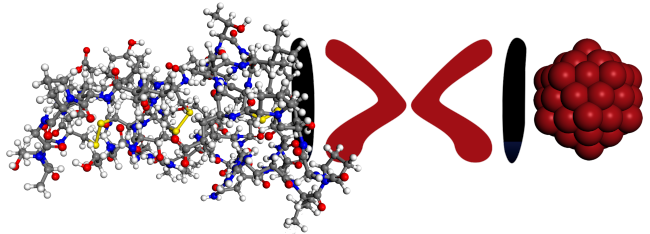1
Molecular Properties, Wavefunction Analysis, and Interfaces to Visualization Tools / hybrid functional and bandgap.
« Last post by Wonseok on July 16, 2024, 01:31:31 PM »Dear all,
I am currently working on adjusting the parameters of hybrid functionals, specifically hse_own, to match the bandgap of a solid system with experimental values.
Below is a control file used for calculating a diamond structure composed of 8 carbon atoms, running the ‘riper’ module due to the periodic boundary conditions.
After reading the manual, I understood that the HSE formula* corresponds to the hse_own parameters (alpha, beta, omega) as follows:
"""
alpha = a
beta = 1 - a
omega = omega
"""
In the same control file, I varied the type of functional and the parameters as shown in the table below and checked the bandgap using the ‘eiger’ command.
functional | α | β | ω | Bandgap[eV]
pbe | X | X | X | 4.86588
hse06 | 1/4 | X | 0.11 | 6.04238
hse_own | 1/4 | 3/4 | 0.11 | 13.2466
hse_own | 1/4 | 2/4 | 0.11 | 13.2466
hse_own | 1/5 | 4/5 | 0.20 | 13.2466
However, the calculated bandgap using hse06 and hse_own shows a significant difference, with the values differing by about two times. Additionally, for hse_own, it is puzzling that the bandgap does not change despite adjusting the parameters.
I would like to confirm whether my understanding of the parameter relationships is correct. If it is not, I would appreciate an explanation of how each parameter (alpha, beta, omega) relates to the HSE formula*.
I would be grateful for any advice or suggestions.
Best regards,
*HSE formula* (Hybrid functional - wikipedia)

I am currently working on adjusting the parameters of hybrid functionals, specifically hse_own, to match the bandgap of a solid system with experimental values.
Below is a control file used for calculating a diamond structure composed of 8 carbon atoms, running the ‘riper’ module due to the periodic boundary conditions.
Code: [Select]
$title
$symmetry c1
$user-defined bonds file=coord
$coord file=coord
$optimize
internal off
redundant off
cartesian on
global off
basis off
$cell angs
3.55103808 3.55103808 3.55103808 90.0 90.0 90.0
$periodic 3
$kpoints
nkpoints 6 6 6 # Gamma point calculation
$atoms
c 1-8 \
basis =c pob-TZVP \
jbas =c universal
$basis file=basis
$scfmo file=mos
$closed shells
a 1-24 ( 2 )
$scfiterlimit 300
$thize 0.10000000E-04
$thime 5
$scfdamp start=0.300 step=0.050 min=0.100
$scfdump
$scfintunit
unit=30 size=0 file=twoint
$scfdiis
$scforbitalshift automatic=.1
$maxcor 500 MiB per_core
$drvopt
cartesian on
basis off
global off
hessian on
dipole on
nuclear polarizability
$interconversion off
qconv=1.d-7
maxiter=25
$coordinateupdate
dqmax=0.3
interpolate on
statistics 5
$forceupdate
ahlrichs numgeo=0 mingeo=3 maxgeo=4 modus=<g|dq> dynamic fail=0.3
threig=0.005 reseig=0.005 thrbig=3.0 scale=1.00 damping=0.0
$forceinit on
diag=default
$energy file=energy
$grad file=gradient
$forceapprox file=forceapprox
$dft
functional pbe
gridsize m5
$scfconv 7
$jbas file=auxbasis
$ricore 500
$rij
$marij
$marij
$rundimensions
natoms=8
nbf(CAO)=152
nbf(AO)=144
$last step define
$end
After reading the manual, I understood that the HSE formula* corresponds to the hse_own parameters (alpha, beta, omega) as follows:
"""
alpha = a
beta = 1 - a
omega = omega
"""
In the same control file, I varied the type of functional and the parameters as shown in the table below and checked the bandgap using the ‘eiger’ command.
functional | α | β | ω | Bandgap[eV]
pbe | X | X | X | 4.86588
hse06 | 1/4 | X | 0.11 | 6.04238
hse_own | 1/4 | 3/4 | 0.11 | 13.2466
hse_own | 1/4 | 2/4 | 0.11 | 13.2466
hse_own | 1/5 | 4/5 | 0.20 | 13.2466
However, the calculated bandgap using hse06 and hse_own shows a significant difference, with the values differing by about two times. Additionally, for hse_own, it is puzzling that the bandgap does not change despite adjusting the parameters.
I would like to confirm whether my understanding of the parameter relationships is correct. If it is not, I would appreciate an explanation of how each parameter (alpha, beta, omega) relates to the HSE formula*.
I would be grateful for any advice or suggestions.
Best regards,
*HSE formula* (Hybrid functional - wikipedia)



 Recent Posts
Recent Posts